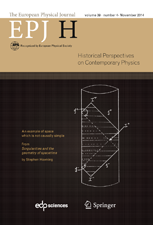May the fifth force be with you

Discovering possible new forces in nature is no mean task. The discovery of gravity linked to Newton's arguably apocryphal apple experiment has remained anchored in popular culture. In January 1986, Ephraim Fischbach, Physics Professor from Purdue University in West Lafayette, Indiana, had his own chance to leave his mark on collective memory. His work made the front page of the New York Times after he and his co-authors published a study uncovering the tantalising possibility of the existence of a fifth force in the universe. In an article published in EPJ H, Fischbach gives a personal account of how the existence of the gravity-style fifth force has stimulated an unprecedented amount of research in gravitational physics - even though its existence, as initially formulated, has not been confirmed by experiment.
Back in the late 1980s, Fischbach and colleagues reanalysed data from a classical physics study, known as the Eötvös Experiment, comparing the accelerations of samples of different chemical compositions to the Earth. His interpretation went against previous understanding, suggesting that acceleration varies depending on the elements' chemical composition. In theory, this force would coexist with gravity, but it would appear in an experiment in the form of a gravity-like long-range force, whose effects would extend over macroscopic distances. It was attributed to the exchange of any of the ultra-light quanta, which are predicted in theories that unify all existing forces under a single, consistent theoretical framework.
About thirty years of research later, there is no evidence for the existence of any deviation from the predictions of standard gravity at any distance scale. Nor is there any experimental confirmation for the original model for a fifth force, which would be proportional to the number of baryons in the interacting samples. However, it remains possible that a different kind of fifth force, of a different nature than originally envisaged, could still exist. Meanwhile, this hypothetical force has led to the development of many new theories and novel experiments. For instance, it has stimulated the quest for new macroscopic fields of gravitational strength, and provides another means of studying high-energy physics.
More information: Ephraim Fischbach. The fifth force: A personal history, The European Physical Journal H (2015). DOI: 10.1140/epjh/e2015-60044-5
Provided by Springer




















